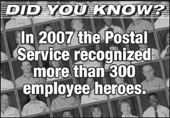Chapter 3 Our Workforce
As a labor-intensive business, the Postal Service continually seeks to balance human resources in order to provide consistent high-quality service as efficiently as possible. It achieves this through continuous workforce planning, optimizing the mix of employees, recruiting a highly-qualified workforce, providing competitive compensation and benefits, and offering effective job-based training and career development.
Recruitment and Development
RECRUITMENT
Placing the right people in the right jobs is an ongoing Postal Service priority. This year saw the national launch of eCareer, an online job posting and hiring tool that allows applicants in any location to apply for postal jobs at usps.com/employment. Besides being a significant enhancement to the previously manual process, eCareer will provide a wide range of metrics expected to help future workforce planning efforts.
To reinforce the value and importance of diversity in its workforce, the Postal Service participates in a number of events and conferences highlighting employee contributions, including the annual Public Service Recognition Week career fair. These events are also an important component of recruitment efforts, providing a broad audience for information about the value of a Postal Service career to prospective employees. Postal participation in national events included the Blacks In Government National Training Conference; the National Black MBA Association Conference; the Urban League; the Society of American Indian Government Employees; the National Congress of American Indians; the League of United Latin American Citizens; the National Council of La Raza; the National Hispana Leadership Institute; and the Asian Pacific American Federal Career Advancement Summit.
The Postal Service is among the nation’s largest employers of veterans and disabled veterans and actively recruits men and women in uniform. In 2008, the Postal Service employed 159,795 veterans. Of this group, 55,609 received injuries while in uniform; of that number, 15,679 were rated at 30 percent or more disabled. Competitive procedures are used to select individuals with disabilities for employment. People with severe disabilities receive noncompetitive employment consideration through referrals from state departments of vocational rehabilitation or the Department of Veterans Affairs. This year the Postal career workforce included 38,286 employees with reported disabilities.
The newly redesigned Management Intern program creates additional opportunities for recruitment and placement of people with specialized training and skills. Business units benefit from the ability to hire talented university graduates. Recruitment partnerships have been developed with a number of universities, including the University of Maryland, Virginia Polytechnic Institute and State University, Michigan State University, Penn State University, and George Mason University.Implementing telecommuting and alternate work schedule (AWS) programs for Headquarters and Headquarters Field Unit exempt employees is part of a long-term strategy to recruit and retain top performers. AWS allows employees to adjust schedules to fit individual needs as well as balance work and family responsibilities. Telecommuting allows employees to work at home or in a satellite location, which also reduces fuel use.
DEVELOPMENT
The William F. Bolger Center for Leadership Development is the national executive management and leadership training center for the Postal Service. Its mission is to continue to provide a premier learning environment for managers to develop, plan, and grow personally and professionally. Over 95,000 people used the center in 2008, including 34,297 postal employees who attended courses and meetings. Training and conference support for non-postal clients generated more than $3 million.
The Postal Service is preparing future leaders by making management training more relevant, improving communications, and providing tools to improve leadership performance.
 A revitalized Advanced Leadership Program (ALP) was launched for high-performing employees this year, with a streamlined format, reduced from 4 to 3 weeks. The redeveloped curriculum includes a blend of classroom, eLearning, and business simulation. A new ALP Web tool provides participants with a central repository for program information and a convenient means to share experiences and collaborate online. ALP program enhancements suggested by prior attendees have been incorporated into class guidelines and simulations. Another significant change is the elimination of the mandatory college course requirement. The developmental needs of participants after ALP will be customized by executive sponsors. This year 32 ALP graduates were promoted to executive positions.
A revitalized Advanced Leadership Program (ALP) was launched for high-performing employees this year, with a streamlined format, reduced from 4 to 3 weeks. The redeveloped curriculum includes a blend of classroom, eLearning, and business simulation. A new ALP Web tool provides participants with a central repository for program information and a convenient means to share experiences and collaborate online. ALP program enhancements suggested by prior attendees have been incorporated into class guidelines and simulations. Another significant change is the elimination of the mandatory college course requirement. The developmental needs of participants after ALP will be customized by executive sponsors. This year 32 ALP graduates were promoted to executive positions.
The Managerial Leadership Program (MLP) is a new 2-week development program designed to enhance the leadership skills and professional growth of high potential mid-level managers. The foundation of MLP is the Managerial Competency Model which identifies essential management skills relevant to the postal workplace. The first three MLP classes were completed in October 2008 and included 70 field and 18 headquarters participants.
Three new Functional Skills Development courses were offered for recently promoted or reassigned managers in key mid-level field positions. New courses are Manager, Customer Service; Manager, Operations Program Support; and Postmaster level 21 and 22. Employees promoted to these positions are automatically enrolled.